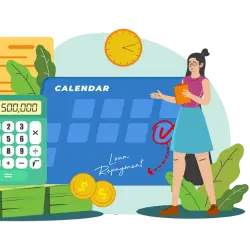TABLE OF CONTENTS
If you’re looking for funding options or a business loan, you may come across what’s called an acceleration clause. This is a vital part of a loan agreement that many overlook. However, when you’re looking at loan options, there are aspects you may not already know about. This can mean the difference between a successful business and shutting down as the average business loan exceeds $100,000. It’s important to understand these aspects so you know the risks you could be taking. Read on to learn what an acceleration clause is, the definition, how to initiate one, and examine a sample.
What is an Acceleration Clause?

The official acceleration clause definition is a contract provision that lets a lender require a borrower to repay the entire outstanding balance on a loan if they violate certain requirements. An acceleration clause states all the possible reasons that the lender can demand loan repayment in full. For example, the lender may require the borrower to maintain a certain credit rating or face repayment.
By definition, an acceleration clause is intended to help protect lenders that extend financing to businesses that need capital. Basically, the clause lets lenders demand the remainder of the loan amount when certain terms aren’t met. This clause is also called an acceleration covenant.
An acceleration clause is similar to asking for collateral but without the use of goods or assets. Instead, it’s a precaution included to facilitate the lending of money.
What Initiates an Acceleration Clause?
Generally, the lender is the one that initiates the acceleration clause. This is because the clause’s purpose is to protect them from risks that the borrower may pose. A lender can require the borrower to complete payment on the loan before the terms of the loan have ended. Typically, these clauses are dependent on on-time payments.
It’s common to find these clauses in mortgage loans to help reduce the risk of default for the lender. Generally, an acceleration clause in a mortgage loan requires the borrower to pay off the rest of the balance if they break the terms.
When a lender invokes an acceleration clause, it relieves the borrower of making additional interest payments once they pay in full. This occurs because when the lender invokes the clause, the borrower ends up paying off the loan earlier than the initial term.

Acceleration clause example in real estate
As mentioned, lenders typically call on an acceleration when a borrower misses payments. The number of delinquent payments that invoke the clause may vary by the terms of the loan.
In some cases, lenders can invoke an acceleration clause from a borrower missing just one payment. In other cases, the clause would not come in until after a borrower misses two or three payments. A lender could also invoke it if they sell or transfer the property to another party.
Here’s an acceleration clause example for you: Let’s say that you have a borrower that has a ten-year mortgage loan. In the 5th year of the loan, the borrower fails to make a payment. According to the terms of the acceleration clause sample, the borrower must repay the remaining balance after one missed payment.
The lender would contact the borrower promptly to pay off the rest of the mortgage loan balance. There are two things that could happen from here. The first scenario is that the borrower is able to repay the balance in full. They will then take full ownership of the property and receive the title of the home. The second scenario is that the borrower is unable to repay the remaining balance. This is a breach of contract and gives the lender the right to foreclose the property and take possession of it.
Invoking the Acceleration Clause
Since mortgages and business funding sums are normally large, they commonly include acceleration clauses. This clause helps protects lenders from the risk of a borrower defaulting on a loan. Typically when the lender triggers this type of clause, they will send a letter outlining how much the borrower owes.
Here are a few situations that could trigger an acceleration clause:

Single-trigger acceleration
A single-trigger acceleration means that a single event has triggered the acceleration clause to be invoked for your loan. Here are a few examples of single-trigger acceleration causes:
- The sale or owner transfer of the business
- A single missed payment
- Filing for bankruptcy
- The borrower falling behind on other loan agreements
Double-trigger acceleration

In contrast, double-trigger acceleration refers to an acceleration clause invoked due to multiple events. Unfortunately, some of these events can be out of the borrower’s hands but are still counted against them.
Here are a few examples of double-trigger acceleration causes:
- Multiple, missed payments
- The sale or transfer of a business coupled with the borrower leaving the organization
- The borrower falling behind on loan payments and other loan agreements.
Final Thoughts
As a business owner, it can be difficult managing the many aspects of business operations. When you factor in business funding agreements and clauses, it can be more than overwhelming. Therefore, it’s important to understand all of your responsibilities as a borrower prior to signing loan agreements.
After reading this article you should be able to answer the question, “What is an acceleration clause?” with confidence.






